Anguloa
Anguloa, commonly known as tulip orchids, is a small orchid genus closely related to Lycaste. Its abbreviation in horticulture is Ang. This genus was described by José Antonio Pavón and Hipólito Ruiz López in 1798. They named it in honor of Francisco de Angulo, Director-General of Mines of Peru.
| Anguloa | |
|---|---|
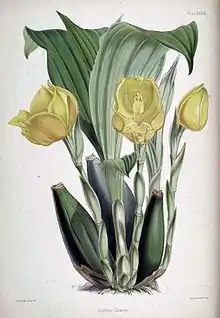 | |
| Anguloa clowesii | |
| Scientific classification | |
| Kingdom: | Plantae |
| Clade: | Tracheophytes |
| Clade: | Angiosperms |
| Clade: | Monocots |
| Order: | Asparagales |
| Family: | Orchidaceae |
| Subfamily: | Epidendroideae |
| Tribe: | Cymbidieae |
| Subtribe: | Maxillariinae |
| Genus: | Anguloa Ruíz & Pav. |
| Type species | |
| Anguloa uniflora Ruíz & Pav. | |
| Species | |
|
See text | |
This genus is found on the forest floor at high elevations from Venezuela, Colombia, Ecuador, Bolivia and Peru.[1][2][3]
Description
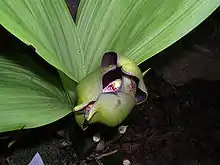
Tulip orchids are rather large terrestrial and sometimes epiphytic plants with fleshy pseudobulbs longer than 20 cm. The long, lanceolate and plicate leaves of a full-grown Anguloa can be more than 1 m long. Two to four leaves grow from the base of each pseudobulb. The leaves are deciduous, and are shed at the start of each new growth.
The flowers of these orchids have a strong scent of cinnamon. They are of waxy appearance and are (in wild species) either of two colors, depending on the species – greenish white, or yellow to red. A single flower per inflorescence arises from the base of each new pseudobulb. The white tulip orchids have six inflorescences per pseudobulb, the other can produce up to twelve inflorescences. The sepals have a bulbous shape, resembling a tulip; hence the common name. The lip is three-lobed. The column has four pollinia.
Species
There are 13 species of tulip orchids, including 4 apparently of hybrid origin though established in the wild. Other hybrid tulip orchids are bred by horticulturalists, but do not occur in the wild. The following are currently accepted as of May 2014:[1]
| Image | Name | Described by | Distribution |
|---|---|---|---|
| Anguloa × acostae (A. eburnea × A. hohenlohii) | Oakeley | Colombia | |
 | Anguloa brevilabris | Rolfe | Colombia, Peru |
 |
Anguloa cliftonii | J.G.Fowler | Colombia |
| Anguloa cliftonii var. alba | Oakeley | Colombia | |
| Anguloa cliftonii var. concolor | Oakeley | Colombia | |
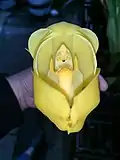 |
Anguloa clowesii | Lindl. | Venezuela and Colombia |
| Anguloa clowesii var. flava | A.DC | Venezuela and Colombia | |
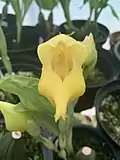 |
Anguloa dubia | Rchb.f. | Colombia and possibly Venezuela |
| Anguloa eburnea | Linden ex B.S.Williams | Colombia, Peru, Ecuador | |
 |
Anguloa hohenlohii | C.Morren | Venezuela and Colombia |
| Anguloa hohenlohii var. macroglossa | (Schltr.) Oakeley | Colombia | |
| Anguloa × rolfei (A. brevilabris × A. cliftonii) | Sander ex Rolfe | Colombia | |
 |
Anguloa × ruckeri (A. clowesii × A. hohenlohii) | Lindl. | Colombia, Venezuela, Peru |
| Anguloa × speciosa (A. tognettiae × A. virginalis) | Linden | Venezuela, Colombia | |
 |
Anguloa tognettiae | Oakeley | Venezuela and Colombia |
 |
Anguloa uniflora | Ruiz & Pav. | Peru |
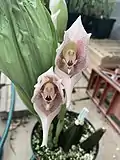 |
Anguloa virginalis | Linden ex B.S.Williams | Venezuela, Colombia, Ecuador, Peru, Bolivia |
| Anguloa virginalis var. turneri | (B.S.Williams) Oakeley | Colombia | |
References
- Kew World Checklist of Selected Plant Families
- Oakeley, Henry F. (1999) Anguloa: The species, the hybrids and a checklist of Angulocastes. Orchid Digest 63(4: Supplement) 1–32. Online version
- Dr. Henry F. Oakeley, 2008 : Lycaste, Ida and Anguloa: The Essential Guide
External links
 Media related to Anguloa at Wikimedia Commons
Media related to Anguloa at Wikimedia Commons Data related to Anguloa at Wikispecies
Data related to Anguloa at Wikispecies- Anguloa photo gallery